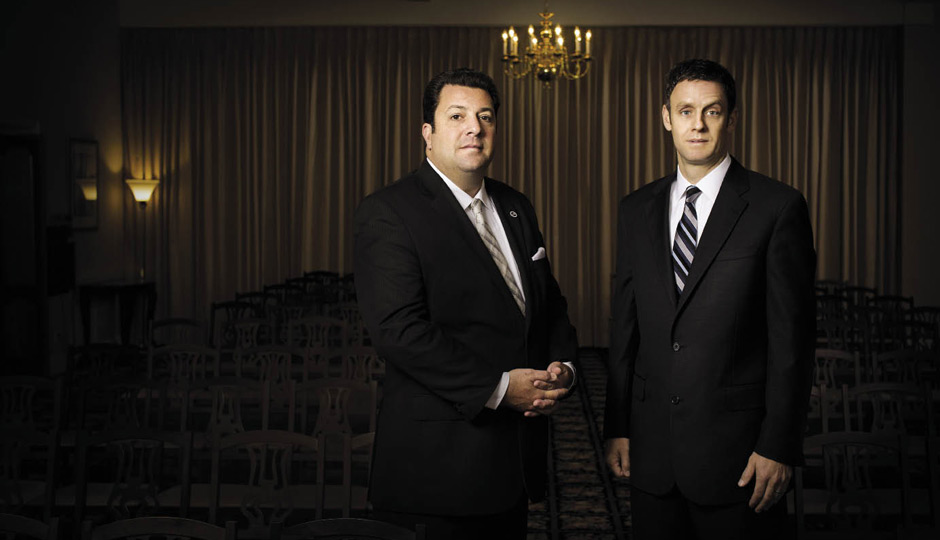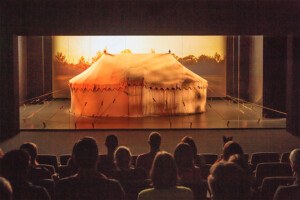The Death of the Funeral Business
When I die just show clips of me and shut the f up. —Tweet from comedian Albert Brooks, 2013
My mom died while I was in my early 20s; my dad, Bill, lived on for another quarter-century. But it wasn’t until he died and I was going through his things that I found a photo of my mother taken for Dress-Down Day at North Penn High, where she’d taught math. She’s in front of a blackboard, wearing big round glasses and a t-shirt showing the Pythagorean theorem. On the back of the photo, she wrote:
Bill doesn’t like this picture but I love it. It’s my favorite “Marcie, the teacher” picture. I would like my grandchildren (?) to have copies one day.
Mom got her wish; her grandkids all have copies of that photo, and since they never knew her, it’s precisely how they “remember” her. Contemporary funerals are like that picture—they’re not about life after death, but about how we want to be remembered, or at least (since the dead can’t control the living) how our loved ones want us to be.
That explains why the Verizon guy is tramping across the handsome floral carpet in the mirror-walled front lobby of the Pennsylvania Burial Co. “We’re in a traditional area,” says fourth-generation funeral director Peter Jacovini, by which he means South Philly, and more specifically the funeral-home-dense stretch of South Broad Street between Wharton and Oregon. The Pennsylvania Burial Co., at Broad and Reed, is built like—well, a vault. “The walls are so thick that we can’t get wi-fi in our parlors,” says Peter’s cousin, Victor Baldi III—also a fourth-generation funeral director, at the adjacent Baldi Funeral Home. So this bastion of tradition, this crystal-and-marble temple, is putting in more routers, for beaming out videos.
“Video makes it a life celebration,” explains Victor, a handsome, beefy Italian guy. And who doesn’t like to celebrate?
“People have so many pictures now—on their laptops, their phones,” adds Peter, who’s more ascetic in appearance. The home’s chapels have been fitted with discreet flat-screen TVs, for showing collages and tributes; prayer cards bear photos of the deceased instead of images of Christ. Victor just had a family that wanted to livestream a funeral service overseas.
The cousins’ old-school business is making other concessions to changing tastes. They’re about to go, um, live with a new website that’s “more interactive and friendlier,” says Victor. “Families can have a memorial online. Visitors can add messages and condolences.” Granted, such newfangled stuff has to be broached delicately here in traditional South Philly. “Some people don’t want their pictures online,” says Victor. But he and Peter recently hired their first-ever female staffer, a grief counselor. (“She’s been well received,” Peter says, sounding a little surprised.)
It’s all part of the biggest trend in funerals: personalization. Taking a cue from Oprah, who reportedly has planned her own funeral, contemporary mourners are trying to make the worn outlines of ritual more authentic and meaningful. We’re singing “My Heart Will Go On” at services, and showing montages of our deceased’s school days, weddings, grandkids. We’re having their cremains shot into space, made into diamonds and interred in coral reefs. The newest disposal method: dissolving the body via alkaline hydrolysis. The resultant liquid washes right down the drain.
Rituals evolve. What stays constant is our need for them, for some way to make sense of the hole in the social fabric that death creates. “While the types of services we offer are changing, our job has remained the same,” say Peter. “People always told stories. We are always remembering who the people were.”
For Victor and Peter’s clients, remembrance is still intimately tied up, mostly, with the body; cremations sans services are still only six percent of their business. “We can be the nicest guys in the world,” says Victor, “but if Mom or Dad doesn’t look good in the casket …
It really helps the family if the deceased looks peaceful.” This explains the pillowy satin linings of the coffins in their Casket Room, where models range from a $650 bare-bones box to a $17,950 bronze number so gorgeous that I’m tempted to climb in.
There’s no sense having a coffin that nice unless people see it—and the body inside it. Almost all of Peter and Victor’s funerals are open-casket. Peter says, “We have a gentleman who does the embalming”—a process in which the deceased is drenched in disinfectant and germicide, the eyes and jaw are fastened shut, blood is drained, the insides of organs are suctioned out, and makeup is used to restore a lifelike look to the corpse.
The embalming, the cosmetics, the cozy casket confines—all are meant to create a therapeutic “memory image” of the deceased that gives mourners closure. Yet even in South Philly, the business is changing. That’s partly due to the recession; Peter and Victor offer more choices now at the low end of the price scale, and a wall of sample urns in the Casket Room for those opting to cremate. On the second floor is a Buddhist chapel, with a special exhaust system to handle the incense monks burn at their ceremonies. “We’re 80 percent Catholic, 15 percent Buddhist and five percent other,” Victor says as he ushers me into this exotic red-and-gold sanctuary.
Statewide, the number of licensed funeral directors dropped by almost 19 percent from 2001 to 2011. Half a dozen funeral homes in Philadelphia have closed in recent years. “Urban homes have their own challenges,” says John Eirkson, executive director of the Pennsylvania Funeral Directors Association. “Parking is harder. Getting around is harder. There are tax issues. Everything is compounded when you’re in the city.” The funeral-home mergers-and-acquisitions consolidation that started out West is hitting the East Coast now. South Philly, once solidly white, Catholic and Italian, today is nearly half black, Asian and Hispanic. And Eirkson has seen dramatic changes in mortuary-school enrollment. “Classes used to be made up of men from funeral-home families,” he says. “Now, women make up 60 percent or more, and the majority aren’t affiliated with funeral-home families.” Small family-owned homes, Eirkson says, “have to adapt—or die.”
But the Pennsylvania Burial Co. is plenty lively. Besides the Verizon guy, drivers and deliverymen and clients come and go. While we talk, Peter and Victor keep an eye through the open front door on their parking lot across the street, which they’re having repaved. The busyness is a reminder that at the heart of what they’re selling is distraction: Do you want this casket or that? What outfit would you like your deceased to wear? In a time of intense emotional distress, they lay out choices that give us the illusion, at least, of control over something we can’t control. And they do so in a setting whose grandeur—marble, mirrors, crystal, plush rugs—offers tribute to our loss in a solemn, satisfying way. We pay them, like the ferryman Charon, to row our dead from this world to the next. It’s an errand too overwhelming for us to face alone.



